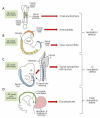Neural tube defects
- PMID: 25032496
- PMCID: PMC4486472
- DOI: 10.1146/annurev-neuro-062012-170354
Neural tube defects
Abstract
Neural tube defects (NTDs), including spina bifida and anencephaly, are severe birth defects of the central nervous system that originate during embryonic development when the neural tube fails to close completely. Human NTDs are multifactorial, with contributions from both genetic and environmental factors. The genetic basis is not yet well understood, but several nongenetic risk factors have been identified as have possibilities for prevention by maternal folic acid supplementation. Mechanisms underlying neural tube closure and NTDs may be informed by experimental models, which have revealed numerous genes whose abnormal function causes NTDs and have provided details of critical cellular and morphological events whose regulation is essential for closure. Such models also provide an opportunity to investigate potential risk factors and to develop novel preventive therapies.
Keywords: anencephaly; folic acid; genetics; spina bifida.
Figures


References
-
- Abdul-Aziz NM, Turmaine M, Greene ND, Copp AJ. EphrinA-EphA receptor interactions in mouse spinal neurulation: implications for neural fold fusion. Int. J. Dev. Biol. 2009;53:559–68. - PubMed
-
- Adzick NS, Sutton LN, Crombleholme TM, Flake AW. Successful fetal surgery for spina bifida. Lancet. 1998;352:1675–76. - PubMed
-
- Ang S-L, Rossant J. HNF-3β is essential for node and notochord formation in mouse development. Cell. 1994;78:561–74. - PubMed
Publication types
MeSH terms
Substances
Grants and funding
LinkOut - more resources
Full Text Sources
Other Literature Sources
Medical

